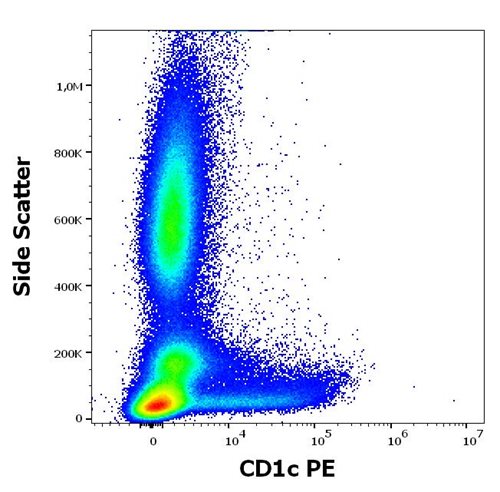Anti-CHI3L1 antibody(DMC483); IgG1 Chimeric mAb

Figure 1. Flow cytometry analysis with Anti-CHI3L1 (DMC483) on Expi293 cells transfected with human CHI3L1 (Blue histogram) or Expi293 transfected with irrelevant protein (Red histogram).
Roll over image to zoom in
Shipping Info:
For estimated delivery dates, please contact us at [email protected]
| Amount : | 100 µg |
| Isotype : | Rabbit/Human Fc chimeric IgG1 |
| Purification : | Purified from cell culture supernatant by affinity chromatography |
| Content : | Lyophilized from sterile PBS, pH 7.4. Normally 5 % - 8% trehalose is added as protectants before lyophilization. Please see Certificate of Analysis for specific instructions of reconstitution. |
| Storage condition : | Store at -20°C to -80°C for 12 months in lyophilized form. After reconstitution, if not intended for use within a month, aliquot and store at -80°C (Avoid repeated freezing and thawing). Lyophilized proteins are shipped at ambient temperature. |
| Uniprot ID : | P36222 |
| Alternative Name : | ASRT7; CGP-39; GP-39; GP39; HC-gp39; HCGP-3P; hCGP-39; YK-40; YKL-40; YKL40; YYL-40 |
Description :Anti-CHI3L1 antibody(DMC483); IgG1 Chimeric mAb
Chitinases catalyze the hydrolysis of chitin; which is an abundant glycopolymer found in insect exoskeletons and fungal cell walls. The glycoside hydrolase 18 family of chitinases includes eight human family members. This gene encodes a glycoprotein member of the glycosyl hydrolase 18 family. The protein lacks chitinase activity and is secreted by activated macrophages; chondrocytes; neutrophils and synovial cells. The protein is thought to play a role in the process of inflammation and tissue remodeling. [provided by RefSeq; Sep 2009]
Chitinases catalyze the hydrolysis of chitin; which is an abundant glycopolymer found in insect exoskeletons and fungal cell walls. The glycoside hydrolase 18 family of chitinases includes eight human family members. This gene encodes a glycoprotein member of the glycosyl hydrolase 18 family. The protein lacks chitinase activity and is secreted by activated macrophages; chondrocytes; neutrophils and synovial cells. The protein is thought to play a role in the process of inflammation and tissue remodeling. [provided by RefSeq; Sep 2009]
FACS 1:100
For Research Use Only. Not for use in diagnostic/therapeutics procedures.
|
There are currently no product reviews
|


















.png)









